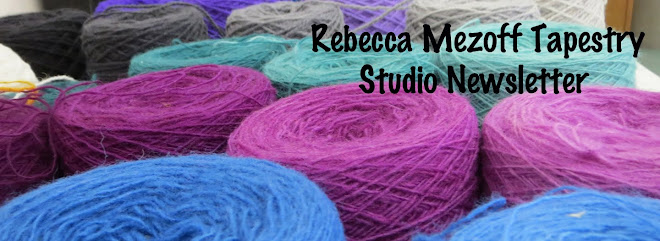But tonight I unpacked this tapestry.
 |
| Rebecca Mezoff, The Goddess's Heart Song, 31 x 34 inches, hand-dyed wool tapestry |
I looked closer and saw this.
I scraped away the little semi-translucent trails and saw places where it seemed like the nap of the tapestry has been chewed. It is hard to see in the photograph, but here it is. See the little trough in the center of the photo?
So does this evidence suggest moths? (I can't imagine it is anything else.)
And if so, what do I do about it. I think I need some help on this one.
As soon as I post this cry for help, I will vacuum the tapestry. Does anyone know what I should do after that to make sure I save this piece and don't have an infestation? I know that people put yarn in the freezer, take it out and thaw it, and then freeze it again. Is this a good procedure for a tapestry? I certainly don't want any of my other pieces infested. This piece was one of only a few that were in that storage locker. The ones I had with me seem to be fine.
And are there any other thoughts on using cedar? I won't use moth repellant as I don't want that chemical in my environment. I do hang my tapestries 3/4 inch from the wall. The little buggers may have found the tapestry in storage. Probably someone in the next locker was storing thrift store sweaters. Sigh.
Heaven forbid I introduce moths into a new house and they find their way into my extensive yarn stashes. I shudder to think of the potential catastrophe. I don't have any clothes worth two cents, but my yarn... well, they better not mess with the yarn.









My understanding is that moths like dirt and darkness, and are repelled by light and strong scents. The only "dirt" that might have been leftover in your tapestry could be lanolin. Otherwise, it's not like a dirty (ie sweaty) place. Repellents can be any combination of strong smelling scents, ie cedar or I make up little bags of black peppercorns, lavender, and cinnamon sticks. Smells good and keeps moths away. The freezing/re freezing thing is supposed to take about two weeks of deep freeze. But anyway, moths generally make holes. This doesn't look mothy to me. Could it be something else - dunno, maybe mice (who are always gathering stuffing and fibers for nesting materials?). Throw the potpourri on all the yarn and it will keep a lot of bad things away. Good luck!
ReplyDeleteThere are definitely not holes, just barely perceptible little trails under those wiggly bits of translucent something which might have been wet or slimey at some point. The trails were 1-2 inches long and very narrow. Huh. I wonder what else would have done this. It must have happened either when it was hanging in Velarde a year and a half ago and I didn't notice when packing it up (though why wouldn't the damage have gotten worse in storage if this were the case?) or when it was rolled up in storage in the locker. I don't think there is any way a mouse could have gotten into the tube it was packaged in. The damage was on the back of the tapestry rolled to the inside, covered with a muslin cover, wrapped in plastic, placed inside a very sturdy bigger tube and wrapped in plastic again.
DeleteYes, I would say they are moths, I found similar traces on Persian carpets in a home left abandoned for several years (and unfortunately carpets were very damaged)
ReplyDeleteHo nestly I don't think natural remedies work; I believe that all the cedar/ cinnamon, etc are mostly a legend, maybe they work to discourage the occasional moth flying-by, but can't really do much in case of a real infestation.
I solved my infestation with chemicals and they worked...
Moths eat holes (irregularly shaped). Carpet beetles eat holes (perfectly circular). They are there only to eat holes, (ie make a nest to lay eggs, lay eggs and die. You'd find the dead soul somewhere in your packing materials). They are not there to gather nesting material.
ReplyDeleteThis does not look like any infestation of either, rather a passing something-that-leaves-trails. If there are no holes, you have had something else. If you can't find anything bug-like, dead or alive, I'd say it was a passing something-or-other from the gallery hanging. At the minimum, wash the tapestry (can you do this?) well with hot soapy water and dry in the hot sun.
Freezing-thawing works on live bugs. Hatching occurs and more live bugs emerge so freezing must be repetitive. Heating (as in a car trunk in the hot sun) does the same thing, and also must be repeated to catch new hatches.
Smelly things (cedar, lavender, etc.) only make the textile less charming to bugs, they are not poison. If they are hungry, they'll suffer the smells and munch anyway.
If it were me, and I valued the textile, I would roll suspect textiles with moth balls, and put them in bags in the hot sun for a few days, then air them out over a line for another few days until the chemicals dissipate. Then wash and re-store.
There were definitely no holes and once I had vacuumed the tapestry I couldn't tell where the little trails had been. This tapestry was hanging in a house with poor screens and a lot of bugs for several years and I didn't take it down and inspect or vacuum the back. That was likely a mistake (which I won't make again). I can't wash the tapestry, but I can freeze/heat it. I haven't seen anything like this in any other wool I have, yarn or tapestry, so perhaps it is an old isolated incident. Since I don't know whether that is the case though, I will do a shakedown of all the yarn and tapestries. It probably should be a habit. I think with a good airing, vacuuming of the tapestries, and frequent cleaning of the stash, I shouldn't have a problem in New Mexico. Heaven help me if I move somewhere more humid.
ReplyDeleteUnfortunately you can have a moth problem in New Mexico as I have had a couple years ago about 50 miles South of where you live now. It was not in Albuquerque but in the East Mountains where it is not humid at all. The moths attacked a clean sweater and left many, many holes. So now everything woolen and silk is hermetically sealed in plastic with lavender sachets enclosed. I am not sure the lavender does anything but it smells good. You can buy lavender dried in large quantities (pounds at a time). I make/sew the sachets out of cheap muslin. I will use moth balls only as a last resort as I find it is almost impossible to loose the smell but they sure are effective. On the web I found some kind of a solution that is supposed to mothproof woolens but I have not used it yet and the stuff is hiding somewhere in my craft room. So even in the Land of Enchantment: prevention, prevention, prevention!
ReplyDeleteRebecca,
ReplyDeletePlease don't use cancer causing mothballs or rely on unprofessional advice, no matter how well meaning it is. There are a ton of myths & mis-beliefs about insect infestation & how to deal with it.
The following links from the Museum Textile Services may be helpful for you... Camille Breeze, the owner of the business & a professional conservator, was a giant help to me in planning how the condor tapestry should be displayed & her website is an invaluable information resource. She was featured in Fiber Art Now last year.
http://www.museumtextiles.com/1/post/2012/04/tis-the-seasonfor-bugs.html
http://www.museumtextiles.com/uploads/7/8/9/0/7890082/identifying_insect_infestations.pdf
I would think that Santa Fe should have a conservator or two that you might be able to call... if you know any gallery owners, ask them for references.
Rebecca: sounds like you've gotten lots of good advice already, but here's my two cents' worth. First, I think those definitely are moth eggs, and perhaps you caught it soon after your piece was invested and luckily, you've had no damage. I am always leery when I buy new yarns or fibers from places like the festivals, so I have always used the freezing method, and it has worked for me...48 hours in the freezer, 24 out, then another 24 in. Also a friend used to work in a store that sold lots of kilims and they would spray their inventory with water that contained a small amount of eucalyptus oil and a wee bit of rubbing alcohol (to emulsify the oil, maybe?). Over the years, I've done this on my yarns and have never had any moth problems. (It's also a good thing to do when your sinuses are clogged! LOL). Definitely do not that that piece home until you have had it cleaned (washed or dry cleaned, preferably) or frozen or both. No sense taking a chance. Best of luck.
ReplyDeleteDefinitely from moths. I've seen these webs many times in museum collections and unfortunately my own home. What you are seeing is called grazing. The moth larvae are eating the loose threads on the surface and haven't yet caused holes but would have if left long enough. After vacuuming ( I hope you disposed of the vacuum bag in a sealed plastic bag outside your house when you were done) you want to freeze the tapestry for at least 5 days in a freezer that is not frost free. If the tapestry is kept below freezing for this long it should take care of the eggs also. A frost free freezer can't be used because it warms up occasionally to allow the frost to melt and this allows the eggs to survive. I would probably re- vacuum after freezing to remove any dead moth bits to discourage any further infestation with something that might like them. Good luck. - Carol
ReplyDeleteGreat tip about the frost free freezer! It makes total sense. In all these years, it's the first I've heard this. Thanks so much!
Delete